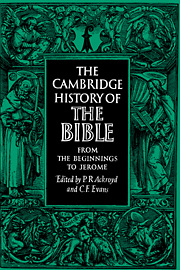Book contents
- Frontmatter
- I LANGUAGE AND SCRIPT
- II BOOKS IN THE ANCIENT WORLD
- III THE OLD TESTAMENT
- 5 THE OLD TESTAMENT IN THE MAKING
- 6 CANONICAL AND NON-CANONICAL
- 7 THE OLD TESTAMENT TEXT
- 8 BIBLE AND MIDRASH: EARLY OLD TESTAMENT EXEGESIS
- IV THE NEW TESTAMENT
- V THE BIBLE IN THE EARLY CHURCH
- Bibliography
- Abbreviations
- Notes on the Plates
- Indexes
- Plate Section">
- References
8 - BIBLE AND MIDRASH: EARLY OLD TESTAMENT EXEGESIS
from III - THE OLD TESTAMENT
Published online by Cambridge University Press: 28 March 2008
- Frontmatter
- I LANGUAGE AND SCRIPT
- II BOOKS IN THE ANCIENT WORLD
- III THE OLD TESTAMENT
- 5 THE OLD TESTAMENT IN THE MAKING
- 6 CANONICAL AND NON-CANONICAL
- 7 THE OLD TESTAMENT TEXT
- 8 BIBLE AND MIDRASH: EARLY OLD TESTAMENT EXEGESIS
- IV THE NEW TESTAMENT
- V THE BIBLE IN THE EARLY CHURCH
- Bibliography
- Abbreviations
- Notes on the Plates
- Indexes
- Plate Section">
- References
Summary
Although intertestamental and rabbinic Judaism may correctly be defined as a ‘religion of the Book’, religion in which practice and belief derive from the study and interpretation of scripture, it would be false to assume that biblical exegesis itself is essentially and necessarily a post-biblical phenomenon. No one familiar with the Old Testament can fail to observe the repeated emphasis laid by some of its authors on the obligation to meditate on, recite, and rethink the Law. It was no doubt a midrashic process such as this which was partly responsible for the formulation of the more recent legal codes, the Deuteronomic and the Priestly, and its influence becomes even more apparent in post-exilic literature (Chronicles and Daniel) and certain of the Apocrypha (Ecclesiasticus). Post-biblical midrash is to be distinguished from the biblical only by an external factor, canonisation. By common though mysterious consent, and using criteria which largely elude us, the Palestinian religious authorities decided, probably at about the end of the third century B.C., to arrest the growth of sacred writings and establish a canon. With one exception, Daniel, their policy was successfully carried through, and from then on the nation's religious and moral guidance was entrusted not to writers but to interpreters. Yet the old tendency to express all fresh insight in the form of new compositions did not vanish without putting up valiant resistance, as is manifest in the Septuagint canon (by nature more receptive than the Palestinian) and to a lesser extent in the integration of commentary and scripture found, for instance, in the Palestinian Targums, some of the Pseudepigrapha, and Josephus' Jewish Antiquities.
- Type
- Chapter
- Information
- The Cambridge History of the Bible , pp. 199 - 231Publisher: Cambridge University PressPrint publication year: 1970
References
- 5
- Cited by

